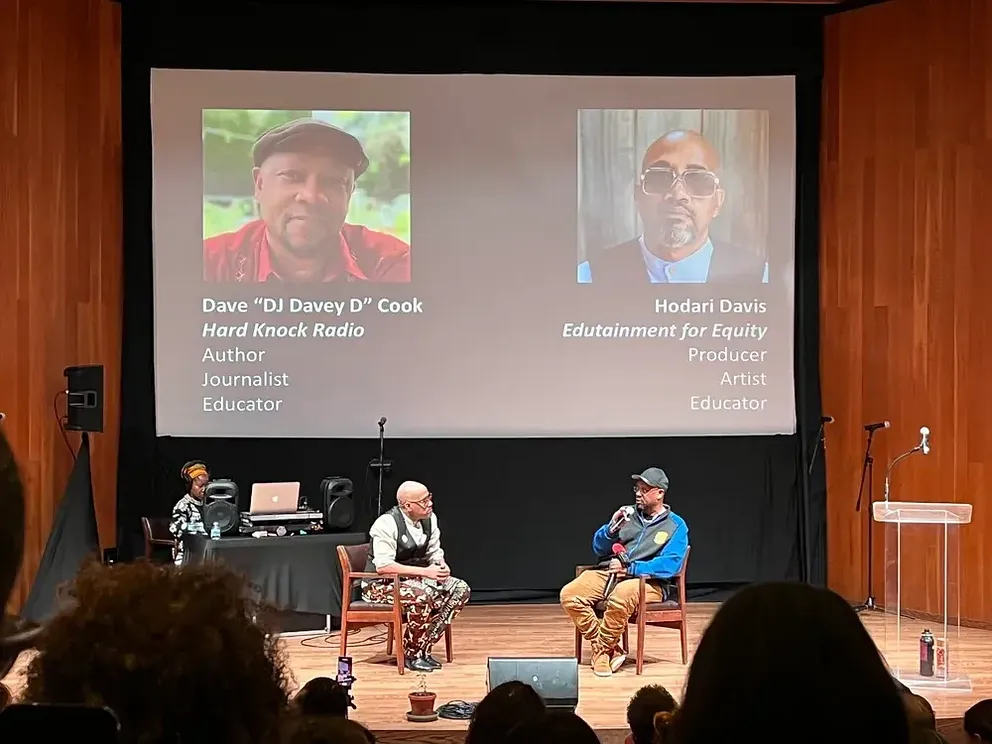The Exhibit A: A Town Hall on AntiBlackness in the City of Oakland
James Moore Theater at Oakland Museum of California
March 14, 2024
“What does it say about a city where its children make visualizations to stop gun violence?”
Oakland is known for its Blackness. A drive through downtown will yield scores of colorful and vivid murals of Black folks. The legacy and philosophy of the Black Panther Party is felt, studied, and highly regarded worldwide. That is why Oakland’s anti-Blackness is deeply infuriating, and why a free presentation and discussion on just that at OMCA last week was so critical.
Tunes from DJ Oracle Selassie filled the theater, and we were ready when educator, chief innovation officer of Edutainment 4 Equity, and host for the night Hodari Bayano Davis took the stage and introduced us to Exhibit A. I had an idea of what the content would be, but was not prepared for the experience.
“Exhibit A” was born out of the pandemic originally as an album, and eventually evolved into an exhibit. Davis shared an Ohlone land acknowledgement, and then had us call out names of ancestors to bring their spirits into the room as he poured water offerings into a small potted plant at the edge of the stage. The exhibit was heavily inspired by author, historian, and civil rights activist W.E.B. DuBois’ work at the Paris Exhibition of 1900, where he presented multi-colored infographics and photographs depicting the daily lives of Black Americans in order to humanize the facts and make them more accessible to the white public.
“You can read about our department on our website. I want to talk about anti-Blackness,” stated Department of Race and Equity Director Darlene Flynn. No time was wasted. She referenced the “Long Hot Summer” of 1967 when over 150 riots broke out between Black civilians and white police officers in cities all across the U.S. She reminded us that the researchers who wrote the Kerner Commission of 1968 predicted where we would be today as two separate, unequal societies. Their research found that it was not angry Black men causing violence, but the recipe of white racism: vicious policing, the unjust justice system, segregation, high unemployment, insufficient housing. Together, they result in a pot boiled over.
Davis strongly encouraged us to use our phones, take photos during the film, and share content with our perspectives of anti-Blackness in Oakland after the screening. Finally, the lights dimmed and just like W.E.B. DuBois’ presentation, the film had radiant infographics and illustrations created by Oakland artists accompanying data about local institutional racism. A jazzy neo-soul track with the lyrics, “You ain’t got second chances Black boy, Black boy” played in the background.
“In 1980 Oakland was 47% Black. Oakland is currently 18% Black with over 4000 Black people living in tents, cars, or RVs on the streets.”
“Alameda county is the third most active hub for human trafficking in the United States. Of the over 4100 youth who are being trafficked in this county, 61% are Black.”
“What does it say about a city where its children make visualizations to stop gun violence?”
Under each quote read, “Is this the future of Oakland?”
After the film, the CEO of Edutainment 4 Equity, Candace Wicks-Davis, a.k.a. Mama Candace, took the stage and sang beautifully and soulfully while we posted our snapshots and thoughts.
A conversation followed between Davis and Oakland journalist, educator, and radio personality Dave “DJ Davey D” Cook, who brought us back to the Kerner Commission. He said how three years after the report was published, senator Patrick Leahy deemed the authors pathological and employed the concept of “benign neglect,” which in this case sent the message: stop talking to militant Blacks and focus on serving the needs of Native Americans, Latin Americans, and middle-class Blacks.
Davis, in a white button down, black vest, and red African print harem pants, was fiery and compassionate, while Davey D had a cooling intellectual affect, in a black and blue Warriors zip up. The conversation was difficult and essential, and their energies balanced one another.
The floor was then opened up for the town hall discussion. “It’s my generation that let this happen,” one elder contributed. A key fact, brought up frequently, was that children under 5 were 1.5 times more likely to have asthma because of the 980 freeway in their neighborhood. A city worker told us that when the city got money to get rid of the freeway and plant trees, there was pushback because people were afraid of gentrification. Today’s kids are faced with asthma or displacement.
The night’s curation was effective. I burst into tears when the Young Gifted and Black youth group performed a chant of the African pledge with affirmations like “We will remember the humanity, glory, and suffering of our ancestors.” Not a grievance: a call to action. The big picture solutions? To reclaim wealth and resources, call out institutional racism, and reform by healing ourselves.
The Oakland Museum’s founding credo is the “people’s museum,” meant to represent the richness and diversity that is “The Town.” It certainly lived up to its name on this particular Thursday evening, a space for education and empowerment.






